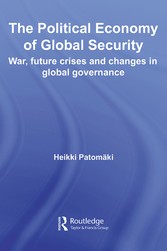
Political Economy of Global Security

von: Heikki Patomäki
Routledge, 2008
ISBN:
Sprache: Englisch
312 Seiten, Download: 4782 KB
Format: PDF, auch als Online-Lesen
4 The origins of the First World War (p. 59-60)
Using historical counterfactuals in constructing open-system explanations
What explains the 1914–18 war that claimed the lives of 10 million people, caused unprecedented levels of social and industrial mobilisation and triggered some of the most remarkable military and, subsequently, political revolutions? There are thousands of scholarly and popular works on the Great War. However, many well-known historical accounts of the First World War contextualise the war only briefly before moving to discussing in detail its outbreak, escalation, strategies, battles, negotiations and outcomes (e.g. Stevenson 2004), or tend to focus on the armaments race of the last decade before the war (e.g. Stevenson 1996). However, there have also been longerterm historical accounts, such as A.J.P. Taylor’s (1971) standard benchmark treatise The Struggle for Mastery in Europe, 1848–1918, Joachim Remak’s (1976) The Origins of World War I, 1871–1914, and Eric Hobsbawm’s (1994a) repeatedly reprinted The Age of Empire, 1875–1914, focusing on the war in the last chapter.
The academic discipline of International Relations (IR) was founded in 1919 in response to the Great War. As a social science, IR has been expected to search for generalisable theories and causal accounts. Its original task was to find out the causes of war in order to prevent the catastrophe of 1914–18 from ever being repeated. The catastrophe was soon repeated – or, in an important sense, continued – in the form of the Second World War. Before long, in the cold war context, the First World War lost its special importance for IR. For instance, both Neorealist (Waltz 1979: 172, Gilpin 1981: 145, 192–94, 200–7) and neo-Marxist (Wallerstein 2000: 258) theories of hegemonic stability and succession present the outbreak of the First World War as a mere instance of theory-derived and simple law-like regularities in world politics. These studies do not compare different explanatory stories or assess critically the available empirical evidence about trends and episodes that led to the outbreak of the war.
Even the more open-minded empirical studies of war and peace (e.g. Vasquez 1999: 268–69, 272–74) have characteristically discussed the origins of the First World War only as an empirical case of one war among numerous wars. A notable exception to this tendency to neglect concrete analysis of the causes of the First World War has been the lateral pressure theory. This was developed by Nazli Choucri and Robert C. North (1975) to synthesise historical narratives of the long-term developments that led to the 1914–18 war and, simultaneously, test quantified hypotheses against the available data. With the exception of the lateral pressure theory and a few notable articles (e.g. Lebow 2000, 2001), and with a partial exception of works such as Richard Hamilton and Holger Herwig’s (2003) The Origins of World War I that focuses on the summer 1914 decisions, late twentieth- century IR has not really challenged the long-term accounts of the classical theorists of imperialism.







